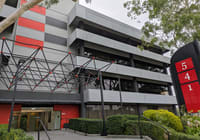
At Australia’s first BTR houses, lawn mowing is included
In an Australian first, developer Resimax is establishing a build-to-rent portfolio of three- and four-bedroom detached houses in greenfield estates on Melbourne’s outskirts and part of the deal is that tenants do not have to mow the lawns.
Privately owned Resimax already has more than 200 homes occupied by tenants in estates in Eynesbury, Wallan and Mernda, in what it expects to build up to a 500-home portfolio, and lawn mowing is part of what they get for their rent, chief executive Aziz “Ozzie” Kheir said.
“We do it as part of our service,” Mr Kheir said. “They can [mow] if they want but we maintain the lawns. We provide it as a service to make it attractive to ensure we get the right tenants.”

The push into standalone homes is new in a country where the BTR market to date has focused on apartments. Resimax’s move is also targeting a different rental niche from inner-city mid-premium market renters.
The median house sale price in Eynesbury, 45 kilometres west of the Melbourne CBD, was $690,000 in June, while in Wallan in the north it was $620,000 and in Mernda, in the north-eastern suburbs, it was $660,000.
The rental yields were lower than they could be, but Resimax wanted to give itself the biggest choice of tenants who would stay in the property for several years, rather than leaving after just one, Mr Kheir said.
“We’re trading around 5 per cent of property value,” he said. “Between 4 and 5 per cent. That could be a lot higher if we took a more aggressive approach. But we have our list price and we just choose right tenants for the property.”
Resimax aims to have 500 homes in the BTR fund by the end of 2025, with 30 per cent in Eynesbury and 70 per cent across Wallan and Mernda sites.
The fund, in which an overseas-based institutional investor had taken a “small” equity stake, would ideally grow, Mr Kheir said. The limitation was not demand, but the developer’s ability to secure more stock.
“It’s more about our capability to deliver much more than that in the short term. There’s no available stock.”
JLL’s national director of residential research, Leigh Warner, said BTR operators needed scale to cover the extra costs required to provide amenities – such as lawn mowing – and the land costs involved in building up a portfolio for detached houses would likely be a hurdle.
“The returns are low – it’s a relatively low-margin operating business – but to provide the amenity and the services to make it attractive for the occupier you need a lot of [homes] to be able to provide that amenity,” Mr Warner said. “You can’t spread that amenity across a smaller number of dwellings.”
It is not unheard of, however. In the US, Lendlease operates standalone build-to-rent properties, known as single-family homes. Low- and medium-density housing formed the basis of the US BTR industry, Mr Warner said.
“Their supply historically was dominated by ‘garden stock’ – low- or medium-density stuff,” he said. “It was only in the last 10-15 years that apartments have really been the majority of the supply.”
Resimax’s rental houses are spread out among the developer’s wider estates of for-sale houses. This marks a difference from institutional-grade BTR portfolios, which need homes to be clustered together, Mr Warner said.
“It needs to be seen as a BTR community, not just a rental within another community that is managed by one owner,” he said.
“It’s got to be a BTR community that would be saleable to another investor for me to be able to think of it as BTR. It can’t be a smattering of it within an estate. It needs to be a defined area and a defined BTR estate, or sub-estate.”











